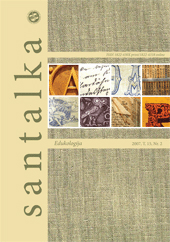Pietryčių Lietuvos mokyklų mokinių nepamokinio ugdymo (-si) ypatumai
Features of the Complementary Education of the Learers of Southeast Lithuania
Author(s): Rimantas VaivadaSubject(s): Social Sciences
Published by: Vilnius Gediminas Technical University
Keywords: complementary education; cultural identity.
Summary/Abstract: The aim of this article is to analyse the state of after-school education of schoolchildren of the Šalčininkai and Vilnius districts and possibilities for the integration of these children into Lithuanian cultural and social life. The results of investigations have shown that in the above mentioned schools the distribution of hours for after-school education is inexpendient (the lessons are not devoted to the development of self-expression and to the teaching of a cultural way of life). Instead, after-school education lessons are being used for filling up gaps in education and for teaching the main subjects. The schools are not able to satisfy schoolchildren’s expectations for after school-activities. There are not enough specialists, money and means of transporta-tion to organise after-school activities and events. The coordination of action between municipalities and school administration is needed to encourage and help the schoolchildren to visit historic sites, cultural, art and sports events.The objective of this article is to consider cultural attitudes of pupils representing general education schools of South-eastern Lithuania from the media aspect.The outcome of research points out that pupils from Polish and Russian classes predominantly watch Lithuanian TV programmes in comparison with those broadcaste from Moscow, consequently special transmissions aiming to acquaint these pupils with Lithuania, its life, history and art should be produced.The referred pupils generally read periodical press in non official languages owing to the insufficient knowledge of Lithuanian. Only in some schools pupils of upper grades read Lithuanian newspapers and journals.Although the pupils from ethnic communities of this region are not hostile to the integration into Lithuania’s life and culture, the obstacles to better aequaintance with Lithuania are infrequent excursions, contacts with pupils of other schools and meetings with prominent Lithuanian personalities. Therefore if is vital to coordinate efforts by municipal and school authorities of this region directing the pupils visiting historical sites, cultural, art and sporting events.
Journal: Santalka: Filologija, Edukologija
- Issue Year: 15/2007
- Issue No: 2
- Page Range: 100-107
- Page Count: 8
- Language: Lithuanian

